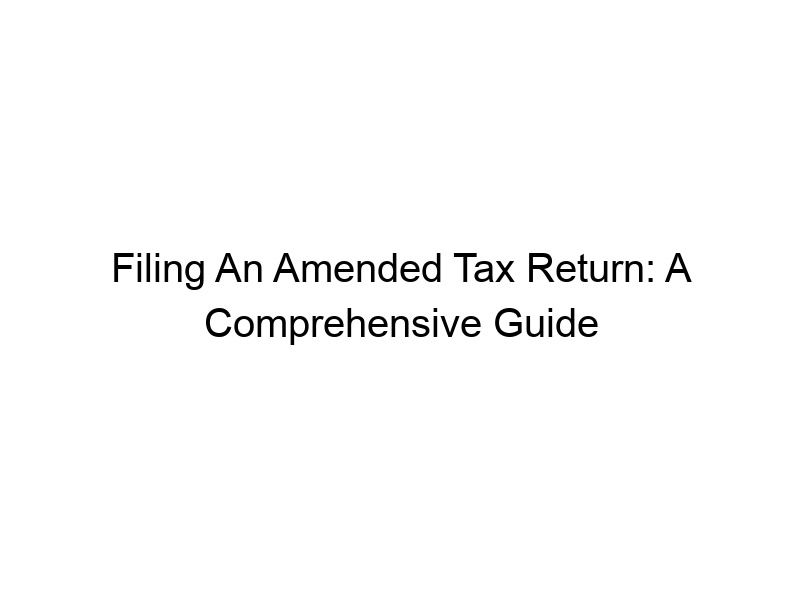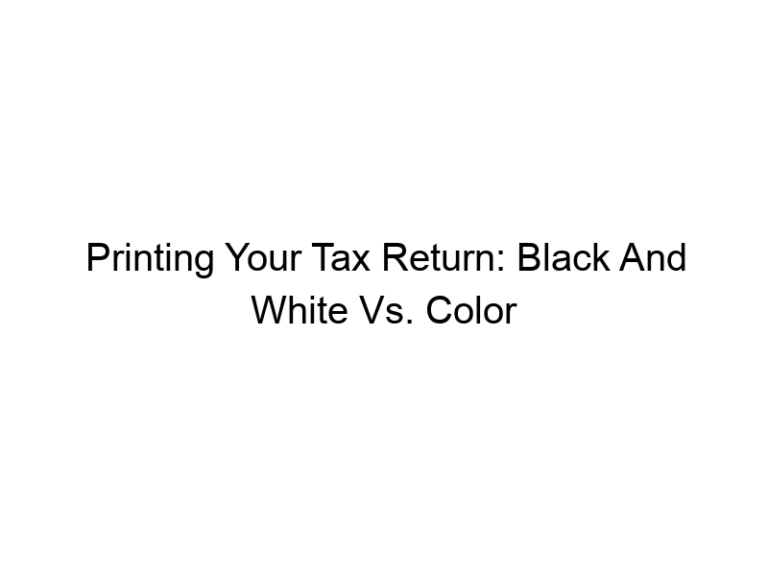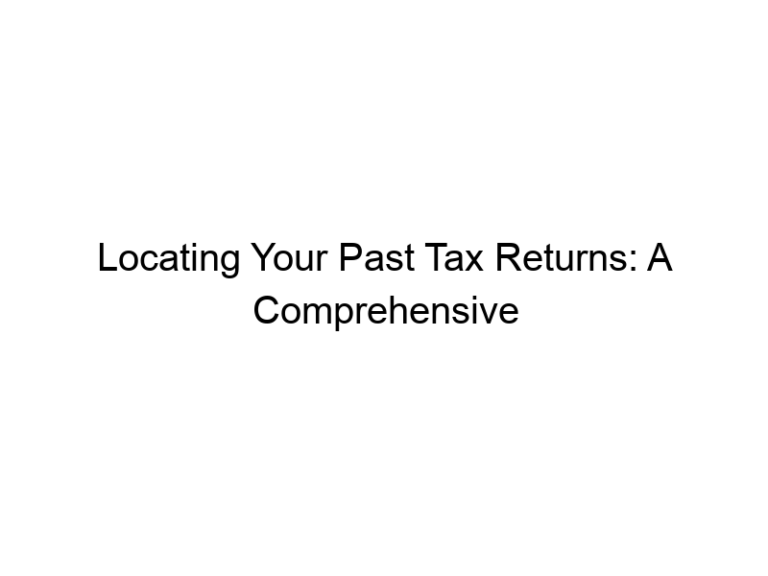Filing An Amended Tax Return: A Comprehensive Guide
Mistakes happen. Sometimes, after submitting your tax return, you discover an error – a missed deduction, an incorrect income amount, or a simple mathematical slip-up. This is where understanding how do you file an amended tax return becomes crucial. This comprehensive guide will walk you through the entire process, from identifying the need for an amendment to successfully submitting your corrected return. We’ll cover everything you need to know, regardless of your tax experience level. You’ll learn about the necessary forms, the timeline, potential pitfalls, and how to avoid future errors.
An amended tax return is a corrected version of your original tax filing. It’s used to rectify errors or omissions made on your initial return (Form 1040). These errors could range from simple mathematical mistakes to more significant issues like
forgetting to report income or claiming an incorrect deduction. The IRS provides Form 1040-X for this purpose.
Why Amend Your Tax Return?
Amending your return is important to ensure accuracy and compliance with tax laws. Failure to correct errors could lead to penalties, interest charges, and even audits. Accuracy ensures you receive the correct refund or pay the accurate amount of taxes owed.
Key Features of Form 1040-X
Form 1040-X mirrors the original Form 1040 in structure but allows you to specifically correct the problematic areas. It requests your original filing information (tax year and social security number) and then guides you through explaining and correcting the errors. You’ll need to provide supporting documentation to justify your amendments.
The Process of Filing an Amended Tax Return
Step 1: Identify the Error
Carefully review your original return, comparing it to all relevant documentation like W-2s, 1099s, and tax receipts. Look for any discrepancies or overlooked items.
Step 2: Gather Necessary Documents
Collect all supporting documents that justify the changes you are making. This might include corrected W-2s, receipts for charitable donations, or proof of additional income or expenses.
Step 3: Obtain Form 1040-X
You can download Form 1040-X from the IRS website (IRS.gov) or obtain a paper copy from a tax professional or IRS office.
Step 4: Complete Form 1040-X
Fill out the form accurately and completely. Explain clearly the nature of each correction, providing specific details and references to the supporting documentation.
Step 5: Attach Supporting Documentation
Attach copies of all supporting documents mentioned in your explanation. Keep originals for your records.
Step 6: Choose Your Filing Method
You can file your amended return electronically or by mail. Electronic filing is generally faster and more efficient.
Electronic vs. Mail Filing
Electronic Filing: Speed and Efficiency
Electronic filing offers speed and convenience. Several tax software programs support e-filing of Form 1040-X. This method significantly reduces processing time compared to mail.
Mail Filing: The Traditional Route
Mail filing involves printing the completed form, attaching supporting documentation, and mailing it to the designated IRS address. This is a slower method and requires careful attention to ensure the correct address is used to avoid delays.
Choosing the Right Method
Consider your comfort level with technology and the urgency of your situation when deciding between electronic and mail filing.
Understanding the Amended Return Timeline
Processing Time
The IRS usually takes 8-12 weeks to process an amended tax return. However, processing times can vary depending on factors such as the complexity of the amendment, the time of year, and the IRS’s current workload.
Tracking Your Amended Return
You can track the status of your amended return using the IRS’s online tools, such as the “Where’s My Amended Return?” tool on their website.
What to Do if Your Amended Return Takes Too Long
If your amended return takes significantly longer than the estimated processing time, you can contact the IRS directly to inquire about its status.
Common Reasons for Amending Tax Returns
Missed Deductions or Credits
Overlooking eligible deductions or credits is a frequent reason for amending. This could include deductions for charitable contributions, student loan interest, or medical expenses.
Incorrect Income Reporting
Errors in reporting income, such as forgetting to include income from a side hustle or misreporting wages, frequently necessitates an amended return.
Mathematical Errors
Simple mathematical errors in calculating taxable income or credits are easily correctable through an amended return.
Changes in Filing Status
Changes in marital status or dependency status can necessitate amending a return to reflect the correct filing status.
Avoiding Errors in Future Tax Returns
Detailed Record Keeping
Maintain meticulous records of all income and expense documentation throughout the year. Organize your documents in a way that is easy to access and review when preparing your taxes.
Utilize Tax Software
Tax preparation software often includes built-in error checks and calculations, helping to minimize mistakes.
Seek Professional Assistance
If you feel unsure about any aspect of tax preparation, consider consulting with a qualified tax professional. They can help you understand complex tax laws and avoid potential errors.
Review Your Return Thoroughly
Before submitting your tax return, carefully review every section to identify and correct any errors before submitting it.
Potential Pitfalls and How to Avoid Them
Incorrect Form Usage
Using the wrong form or failing to complete the form accurately is a common mistake. Carefully review the instructions and fill out all required fields completely.
Missing Documentation
Failure to include supporting documentation can significantly delay processing or even lead to rejection of your amendment. Always include all necessary paperwork.
Inconsistent Information
Providing inconsistent information between your amended return and supporting documents can lead to confusion and delays. Ensure all details align.
Late Filing
Filing an amended return late can result in penalties. File your amendment as soon as you discover the error.
Benefits of Filing an Amended Return
Correct Tax Liability
The primary benefit is ensuring your tax liability is correctly calculated and paid or refunded accordingly. This prevents future issues with the IRS.
Peace of Mind
Filing an amended return provides peace of mind, knowing you’ve taken steps to rectify any errors and maintain compliance with tax regulations.
Avoid Penalties
Correcting errors promptly helps you avoid potential penalties and interest charges.
Maintaining a Clean Tax Record
A timely and accurate amended return helps you maintain a clean tax record, which is important for future financial transactions.
Frequently Asked Questions
What happens if I don’t file an amended tax return?
Failing to file an amended return to correct errors could result in penalties, interest charges, and potential audits by the IRS. The longer you wait, the higher the penalties could be.
How long does it take to process an amended return?
The IRS typically takes 8-12 weeks to process an amended tax return, but processing times may vary.
Can I amend my return more than once?
Yes, you can amend your return multiple times if necessary, but each amendment requires a new Form 1040-X.
What if I made a mistake on my amended return?
If you discover a mistake on your amended return, you’ll need to file another amended return correcting the new errors.
What information should I keep to support my amended return?
You should maintain copies of all supporting documents, such as W-2s, 1099s, tax receipts, and bank statements related to the changes made.
Can I e-file an amended return?
Yes, many tax preparation software programs allow e-filing of Form 1040-X.
What is the deadline for filing an amended tax return?
Generally, you have three years from the date you filed your original return or two years from the date you paid your taxes, whichever is later, to file an amended return.
Final Thoughts
Filing an amended tax return might seem daunting, but understanding the process can alleviate stress. Remember, accuracy is key. By meticulously reviewing your initial return, gathering the necessary documentation, and completing Form 1040-X thoroughly, you can ensure a smooth and efficient amendment process. Don’t delay; file your amended return promptly to avoid potential penalties and maintain compliance with IRS regulations. Take the necessary steps to ensure accuracy in your future tax filings through detailed record-keeping and, if needed, seek professional tax assistance. By following the guidelines outlined in this guide, you can navigate the process confidently and resolve any tax discrepancies. Don’t let mistakes linger; take control of your tax situation and file your amended return today.







